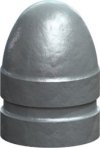I haven't put out any heresy or propaganda for close to a week, and I don't want my edges to get dull--so here goes.
What follows herein is a spin-off from a thread on the CBA Forum I have contributed to that references the late John Kort's (AKA 'W30WCF') work with 44/40 WCF loads having 100%+ densities of RL-7 powder support the bases of cast #427098 bullets like black powder does/did to prevent telescoping bullets in tubular-feed Win M-1873 levergun magazines with pressure gradients that don't cause harm to rifles. 23.5-25.0 grains is the usual dosage of RL-7 with the 200-217 grain castings. I don't shoot 240 grain bullets in 44/40 WCF, so I can't comment on that niche of this stunt work that the CBA thread delves into.
I simply can't leave 'Well enough' alone. It didn't take long for me to apply this same logic sequence to the 32/20 WCF. Sure enough, 12.5 grains of RL-7 did good things for 115-120 grain castings in the Marlin 1894CCL--1250 FPS and decent grouping, and apparent black powder ballistics.
At this point I MUST caution that RL-7 (and IMR-4198) are NOT universal bulk black powder substitutes for BP cartridges! NOT AT ALL! IME in 32/20 and 44/40 the RL-7 behaves in the manner of 'Slow-for application' smokeless powders in these short-cased 140-150 year old calibers. Some of us might remember the stunt work a lot of us did during the heyday of milsurp powders, esp. the 50 BMG and 20mm fuels like WC-860 -867, and -872 in 30-06 , 38/55, and 45/70 applications. Specific to RL-7 and IMR/H-4198 (they are similar in burn rate), we must recall Ross Seyfried's formula for use of smokeless IMR-4198 as a black powder substitute--use the nominal black powder charge weight (E.g., 55 grains in 38/55 or 70 grains in 45/70) and multiply that figure by 0.4 in weight. IME this produces black powder velocities without the BP fouling and corrosion.
The foundation is laid and cured now--let's explore a bit. The 45 Colt is another caliber that came on scene about the same time the 1873 Winchester rifle and its 44/40 WCF cartridge did. Unlike the 44/40, 38/40, and 32/20--the 45 Colt was NOT chambered in companion rifles back in the day like it is now. I am a bit curious why that was the case; perhaps it has to do with the less-prominent rim on the 45 Colt case than those of the WCF cases.....dunno.
This thread concerned itself with safe loads in the S&W 25-5 and Colt SAA class of sideiron. OK, then--the 45 Colt shares a trait with the short WCF calibers (and many other BP calibers) in that it did NOT make a seamless transition to smokeless propellants around the turn of the 20th Century. Specific to the 45 Colt--black powder loads of 40.0 grains of 3F enabled 255 grain lead bullets to achieve roughly 1000 FPS in the 7.5" barrels of the SAA without causing harm to the mechanism. That is handsome performance, even in 2023 metrics. Using our usual run of smokeless pistol powders, the 45 Colt's safe limit has been set in the 825-900 FPS ZIP Code depending upon barrel length with the 255 grain castings; going with that usual run of fuels a velocity yield of 1000 FPS has been termed 'Ruger-level'......perhaps wisely so. Even at 825 FPS, the Lyman #454424 or #454190 is going to get a game animal's or goblin's attention in no uncertain terms. We don't need to 'Gild the lily', but none of us wants to leave any safe performance on the table either.
Let's take up Lyman's #454190--the 'Classic' 45 Colt cast bullet. It shares a trait with Lymans #311008 and #427098--lack of a crimp groove. Like its 31 and 44 caliber counterparts, 454190 was meant to perch on a solid-density column of compressed black powder and have a crimp set around its bullet ogive radius. Such an arrangement would prevent bullet setback in a tubular magazine, I would think. The 45 Colt used the same weight of The Holy Black as the 44/40 WCF to do its heavy lifting, too.
Hmmmm.....AFAIK, Mr. Kort did not extend his research past the 44/40 WCF caliber. In 44/40, 23.5-25.0 grains of RL-7 did the trick--support against bullets telescoping in the magazine as cartridges shunted down the tube, safe pressures for use in M-1873 mechanisms, and absence of BP fouling. (A note of caution, pursued a bit in the CBA thread--using 240 grain bullets in the 44/40, some pressure levels rose past comfy levels for a SAA or '73 application; bullet alloy composition and/or diameter are possible variables at play here).
I am pondering the use of RL-7 with #454190 et al in the 45 Colt at the 23.5-25.0 weight bracket. I have a Bisley Blackhawk that will shrug off pressure anomalies without much fuss and bother--if they take place. Maybe this is an answer for safe loads in the S&W 45 Colts and SAAs. It might also allow for use of #454190 in leverguns chambered in 45 Colt without bullets telescoping.
Bottom line--Mr. Kort came up with an 'Outside the box' solution to solve the issue of obsolete cast bullet designs lacking crimp grooves. Lymans #311008, #401043, #427098, and #454190 have tradition going for them.....and little else. They are a PITA more often than not, and they habitually cast undersize for smokeless applications. They are the 8-track tape deck of bullet casting in the modern age. But people still love them--me included.



